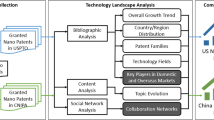Abstract
This study examines technological collaboration in the solar cell industry using the information of patent assignees and inventors as defined by the United States Patent and Trademark Office. Three different collaborative types, namely local (same city), domestic (different cities of the same country), and international collaboration, are discussed. The general status of solar cell patent collaborations, transforming trends of collaborative patterns, average numbers of assignees and inventors for three collaborative types, and international collaboration countries are studied. It is found that co-invented patents and co-assigned patents have both increased in numbers during the four decades studied, and that collaboration between technology owners is very low while the collaboration between inventors is active. Domestic collaboration is the main collaborative pattern for both assignee collaboration and inventor collaboration. The other two collaborative types show contrary trends: international collaboration has slowly risen in the past decades while local collaboration has dwindled. The US has the largest number of internationally collaborative patents worldwide, though such patents account for a low portion of total US patents. In contrast, China has a small total number of patents and internationally collaborative patents, however its international collaborative shares are higher. The international collaboration patents among countries are few. A co-assigned patent analysis indicates that the main international cooperation partner of the United States is Japan. Based on an international co-invented patent analysis, the main international collaboration partners of the United States are Britain, Japan, and Germany; and the United States is also the most important collaboration partner of China.




Similar content being viewed by others
References
Amin, A., & Cohendet, P. (1999). Learning and adaptation in decentralized business networks. Environment and Planning D: Society and Space, 17(1), 87–104.
Archibugi, D., & Pianta, M. (1996). Measuring technological change through patents and innovation surveys. Technovation, 16(9), 451–468.
Balconi, M., Breschi, S., & Lissoni, F. (2004). Networks of inventors and the role of academia: An exploration of Italian patent data. Research Policy, 33(1), 127–145.
Cantwell, J. (1989). Technological innovation and multinational corporations. New York: Blackwell Publishers.
Chen, D. Z., Dong, H. R., & Huang, M. H. (2010). A study of collaborations in solar cell science and technology. The 5th IEEE International Conference on Management of Innovation and Technology, Management of Innovation and Technology, pp 794–799.
Chiu, T. F., Hong, C. F., & Chiu, Y. T. (2010). Trend detection on thin-film solar cell technology using cluster analysis and modified data crystallization. International Conference on Computational Collective Intelligence, 6421(2010), 152–161.
Chiu, T. F., Hong, C. F., Wang, M. Y., Hsu, C. L., & Chiu, Y. T. (2009). Applying chance discovery with dummy event in technology monitoring of solar cell. Lecture Notes in Computer Science, 5579, 333–342.
David, P. A., & Foray, D. (2002). An introduction to the economy of the knowledge society. International Social Science Journal, 54(171), 9–23.
Etemal, H., & Dulude, L. S. (1987). Patenting patterns in 25 large multinational enterprises. Technovation, 7(1), 1–15.
Gao, X., Guan, J., & Rousseau, R. (2011). Mapping collaborative knowledge production in China using patent co-inventorships. Scientometrics, 88(2), 343–362.
Guellec, D., & Van, B. P. (2001). The internationalization of technology analysed with patent data. Research Policy, 30, 1253–1266.
Jäger-Waldau, A. (2007). PV status report 2007-research, solar cell production and market implementation of photovoltaics. European Commission, JRC Technical Notes.
Lei, X. P., Chen, D. Z., Huang, M. H., Zhao, Z. Y., Zhang, X., Zheng, J., et al. (2012). An analysis of innovation competitiveness of China through patent analysis. Malaysian Journal of Library & Information Science, 17(2), 17–32.
Lissoni, F., Llerena, P., Mckelvey, M., & Sanditov, B. (2008). Academic patenting in Europe: New evidence from the KEINS database. Research Evaluation, 17(2), 87–102.
Ma, Z., & Lee, Y. (2008). Patent application and technological collaboration in inventive activities: 1980–2005. Technovation, 28(6), 379–390.
Ma, Z., Lee, Y., & Chen, C. F. P. (2009). Booming or emerging? China’s technological capability and international collaboration in patent activities. Technological Forecasting and Social Change, 76(6), 787–796.
Narin, F. (1991). Globalization of research, scholarly information and patents—ten years trend. Proceedings of the North American Serials Interest Group (NASIG) 6th Annual Conference, The Serials Librarian 21, pp. 2–3.
Ortega, J. L. (2011). Collaboration patterns in patent networks and their relationship with the transfer of technology: the case study of the CSIC patents. Scientometrics, 87(3), 657–666.
SIPO (State Intellectual Property Office of P.R.C.) (2012). Distribution of annual applications for three kinds of patents received from home and abroad. Retrieved Oct. 19, 2012, from http://www.sipo.gov.cn/ghfzs/zltjjb/jianbao/year2011/a/a2.html.
Tappeiner, G., Hauser, C., & Walde, J. (2008). Regional knowledge spillovers: Fact or artifact? Research Policy, 37(5), 861–874.
Wang, M. Y., & Chiu, T. F. (2010). Monitoring the key technology trends by combining chance discovery and survival analysis: Study on solar cell patent documents. Portland International Center for Management of Engineering and Technology, Technology Management for Global Economic Growth, 1–7.
World Intellectual Property Organization (WIPO) (2012). IPC Green Inventory. Retrieved Jan. 30, 2012, from http://www.wipo.int/classifications/ipc/en/est/.
Author information
Authors and Affiliations
Corresponding author
Rights and permissions
About this article
Cite this article
Lei, XP., Zhao, ZY., Zhang, X. et al. Technological collaboration patterns in solar cell industry based on patent inventors and assignees analysis. Scientometrics 96, 427–441 (2013). https://doi.org/10.1007/s11192-012-0944-x
Received:
Published:
Issue Date:
DOI: https://doi.org/10.1007/s11192-012-0944-x




